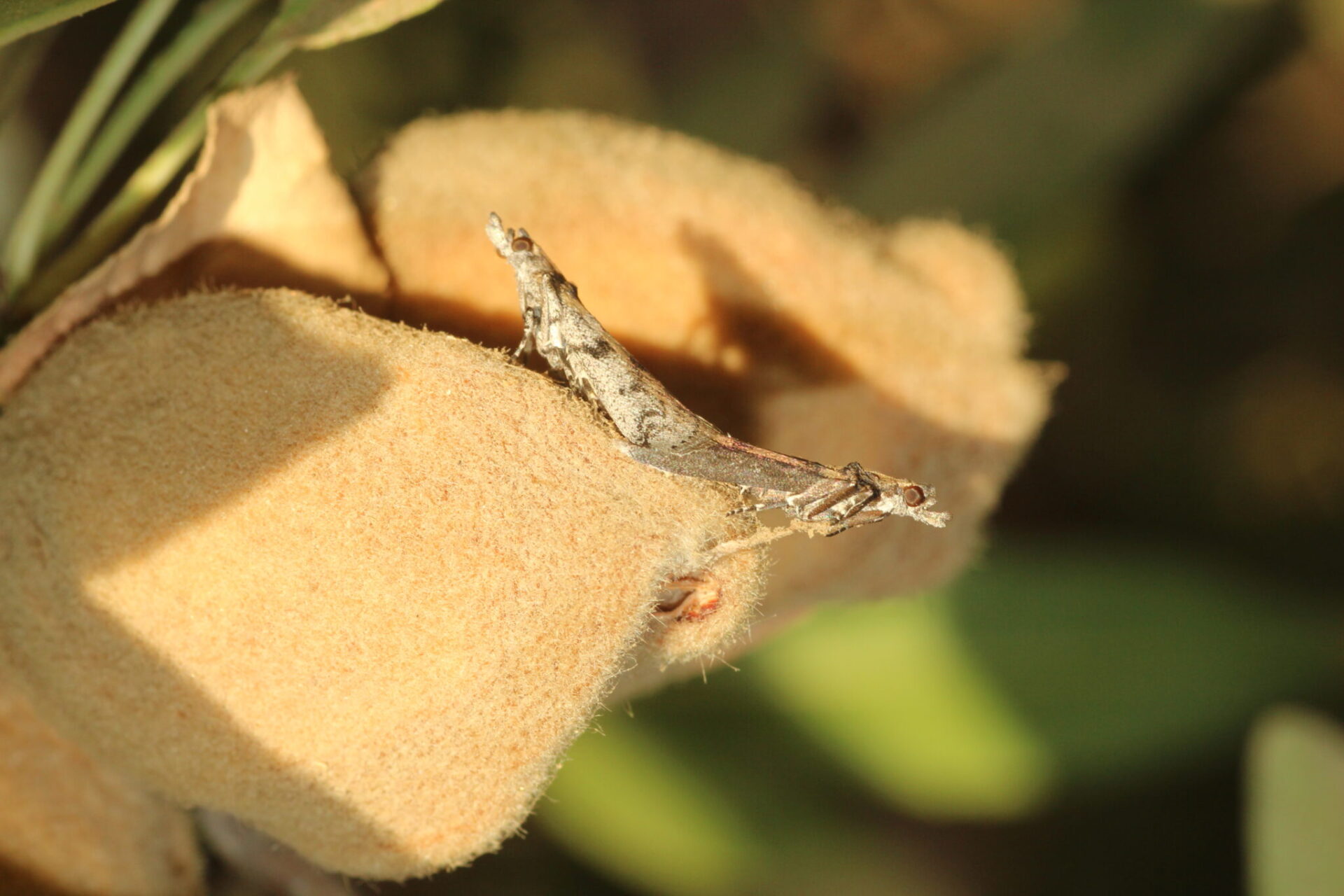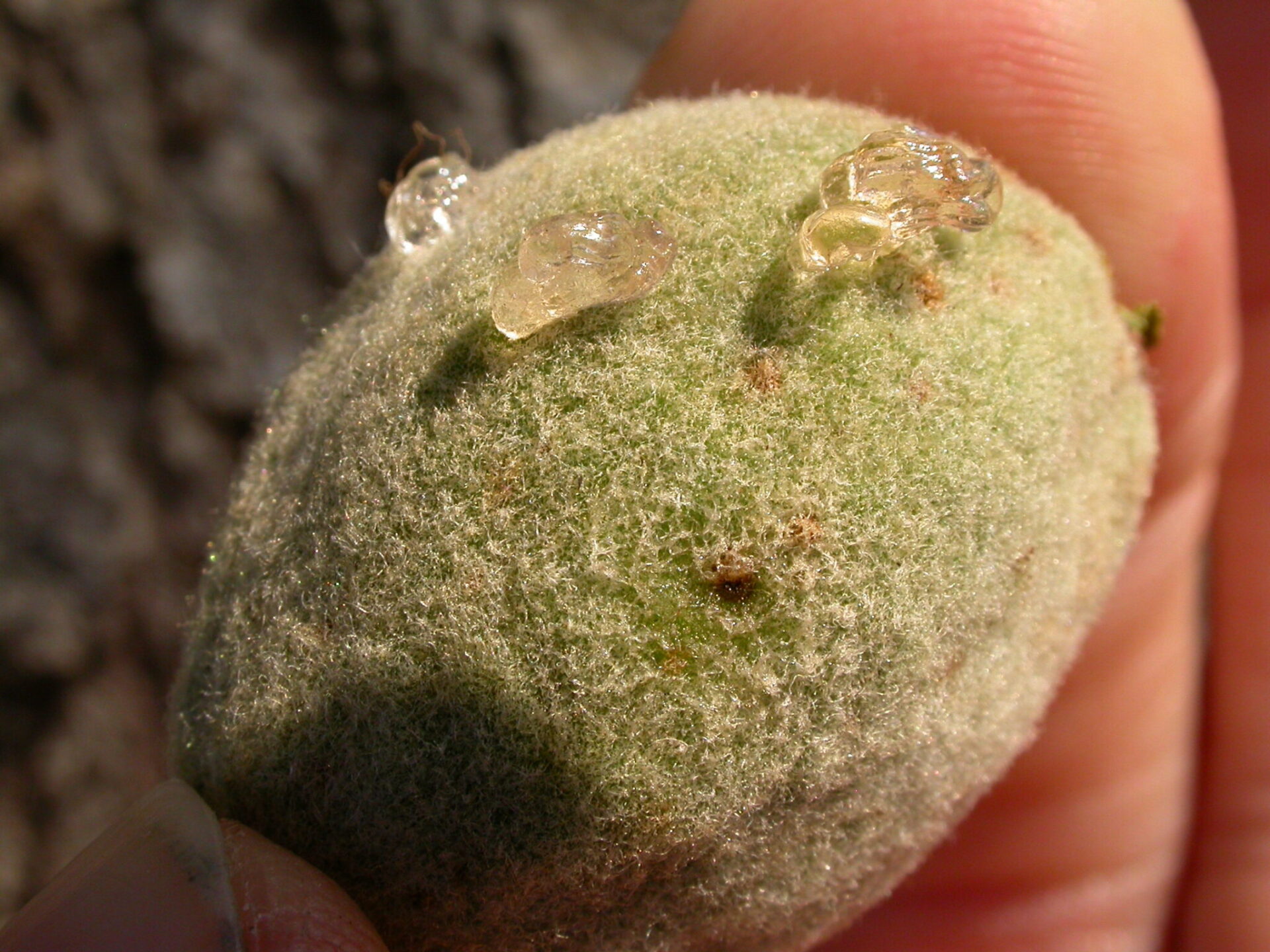
For almond growers looking to cut costs in 2021, ‘May sprays’ present an opportunity that may be hard to pass up. May sprays, which are typically applied in either April or May, can have many purposes related to the management of peach twig borer (PTB), navel orangeworm (NOW), leaffooted bug and spider mites. However, problems with PTB these days are minimal compared to what they used to be, insecticide sprays for NOW are more effective at hullsplit, the need to treat for leaffooted bug is the exception and not the rule, and recent advances in biocontrol have made the need for preventative miticide sprays obsolete. Most growers and PCAs who monitor for each of these pests and make decisions based on principles of integrated pest management will find that the May spray can be skipped altogether in most orchards.
Peach Twig Borer
The term ‘May spray’ was originally coined to control PTB if growers did not have the opportunity to do so during the dormant season and/or bloom. However, despite its historical significance as an almond pest, damage by PTB has become almost irrelevant after trees start bearing fruit, unless perhaps the orchard is located next to commercial stone fruit production and the orchard has a history of damage. Most growers, including those who capture hundreds of PTB in traps, typically report very low to negligible levels of PTB damage in their official USDA kernel quality assessments. These assessments, of course, are what counts.
There are currently two main theories for why PTB is not the problem it used to be. The first is that modern-day precision irrigation practices allow for uniform shell expansion, leading to a good shell seal. When there is a good shell seal, PTB tends to feed outside the shell on the inside of the hull. This is in comparison to the historic use of flood irrigation, where wet-dry cycles during shell expansion caused cracks and splits in the shell that facilitated PTB access into the marketable kernel. The second theory relates to improved biological control. Historically, dormant and in-season applications of organophosphates reduced populations of all ant species. However, modern-day use of selective ant baits allows for control of pestiferous ant species, such as southern fire ant, while allowing the survival of the beneficial native gray ant. This species of ant feeds on PTB larvae, especially while they overwinter inside hibernacula on the trunk. Reductions in the use of organophosphates and pyrethroids have likely also benefited species of parasitoids that attack PTB.
Navel Orangeworm
May sprays for NOW have always been problematic. The most common insecticides for lepidopteran worms, including methoxyfenozide and chlorantraniliprole, do not kill overwintering larvae and pupae that are still in the mummy, do not kill adults that fly in the spring, and can only provide control from the time eggs are laid until the new larva passes below the mummy surface. Unfortunately, the first NOW flight occurs over a long period of time such that even a perfectly timed spray will only kill a small segment of the first-generation eggs and larvae. This also assumes that coverage is excellent, as eggs laid into cracks and crevices without insecticide residue have a good chance for survival. May sprays also do not directly protect kernels of the current year’s crop, including from moths immigrating into the orchard from neighboring tree crops as hull split begins.
Cost-wary growers who plan to make one spray for NOW should apply it at the beginning of hullsplit. If a second spray is needed, it should be applied toward the end of July as residues from the first spray break down, pollinizers are splitting and the third flight is approaching. If the grower is dealing with a NOW nightmare where three sprays are needed, then spending extra money for a May spray may be warranted as the exception, not the rule.
Leaffooted Bugs
Insecticide applications for leaffooted bugs in the spring are only needed sporadically. Cases where treatments are warranted most commonly follow mild winters in orchards near excellent overwintering sites. Key examples include areas that contain plants with foliage, such as urban landscapes, Cyprus trees or citrus orchards, or lots of debris, such as riparian areas along streams or rivers. From March to May, monitor almond orchards for the presence of leaffooted bugs, gummosis associated with a puncture mark on the almond hull and aborted nuts. If found at levels that are not acceptable, consider a treatment. Otherwise, save your money.

Spider Mites and Their Predators
May sprays for spider mites were invented in the early 2000s by almond growers in the lower San Joaquin Valley. At that time in Kern County, it was common for almond orchards to become defoliated by June in the absence of intervention, and it was quickly determined that newly registered abamectin was most effective through its translaminar activity if applied in May before leaves hardened. Ten years later, as generic abamectin products became available and active ingredient prices dropped, May sprays became adopted more widely throughout the entire San Joaquin Valley. Adoption eventually reached a point that ‘preventative’ mite sprays in May became the industry standard practice.
Fast-forward to 2020 and things have totally changed. It is nearly impossible to find mite-induced defoliation in a bearing almond orchard until after hullsplit, and biological control of spider mites is at an all-time high with thanks primarily to ‘greener’ production practices that promote sixspotted thrips. Recent research has shown that this natural enemy is present throughout the San Joaquin and Sacramento Valleys and that overwintering adult thrips become active in almond orchards in April and May. Miticides should only be applied in the spring if a treatment threshold of approximately 40% of leaves infested has been reached, and recently-published research has confirmed that if you find a total of two sixspotted thrips in two Pherocon predator traps (Trécé, Inc) within a week, or a total of three sixspotted thrips in four traps, that there is sufficient biological control to confirm that a miticide is not needed. In most orchards most years, sixspotted thrips density far exceeds this threshold at the typical timing of May sprays. The exceptions are typically cases where the grower has done something that disrupts biological control, such as a pyrethroid spray for leaffooted bugs. It is time for almond growers to make ‘preventative’ miticide sprays obsolete. Abandoning this practice will also help save on costs in a tight year.
Interactions
After monitoring individually for PTB, NOW, leaffooted bug and spider mites, the verdict in most cases will be that no insecticide applications are needed in April or May. However, when exceptions for one of these pests occur, growers should make sure they get the best bang for their buck. If spraying for PTB, choose a product that is also effective against NOW. If spraying for NOW, consider applying it at a timing that is optimal for PTB. If spraying for leaffooted bug, consider the relative merits of different options: pyrethroids are inexpensive and effective but kill natural enemies, abamectin has short-lived effectiveness but is safe on most natural enemies other than sixspotted thrips, and clothianidin is more expensive and has short effectiveness but preserves natural enemies. If applying a miticide, weigh your options between using abamectin (less expensive but toxic to six spotted thrips) or a more expensive miticide not known to impact natural enemies that may help reduce the risk that another miticide treatment is needed later in the season.
When all things are considered, May sprays have great potential to serve as a low-hanging fruit for cost-wary almond growers in 2020. For more information about making ‘May spray’ decisions, consult the UC IPM Pest Management guidelines for almond (www2.ipm.ucanr.edu/agriculture/almond/) or contact your local Cooperative Extension office.















